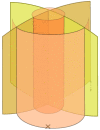Femtosecond-Laser Assisted Surgery of the Eye: Overview and Impact of the Low-Energy Concept
- PMID: 33498878
- PMCID: PMC7912418
- DOI: 10.3390/mi12020122
Femtosecond-Laser Assisted Surgery of the Eye: Overview and Impact of the Low-Energy Concept
Abstract
This article provides an overview of both established and innovative applications of femtosecond (fs)-laser-assisted surgical techniques in ophthalmology. Fs-laser technology is unique because it allows cutting tissue at very high precision inside the eye. Fs lasers are mainly used for surgery of the human cornea and lens. New areas of application in ophthalmology are on the horizon. The latest improvement is the high pulse frequency, low-energy concept; by enlarging the numerical aperture of the focusing optics, the pulse energy threshold for optical breakdown decreases, and cutting with practically no side effects is enabled.
Keywords: femtosecond laser; fs-assisted cataract surgery; high pulse frequency; laser-assisted ophthalmic surgery; low energy.
Conflict of interest statement
A.M. is a consultant to Ziemer Ophthalmics, CH-2562 Port, Switzerland.
Figures
















References
-
- Welch A.J., van Gemert M. Optical-Thermal Response of Laser-Irradiated Tissue. Springer; Berlin/Heidelberg, Germany: 2011.
-
- Kaschke M., Donnerhacke K.-H., Rill M.S. Optical Devices in Ophthalmology and Optometry: Technology, Design Principles and Clinical Applications. WILEY-VCH Verlag GmbH & Co. KGaA; Weinheim, Germany: 2014.
Publication types
LinkOut - more resources
Full Text Sources
Other Literature Sources

